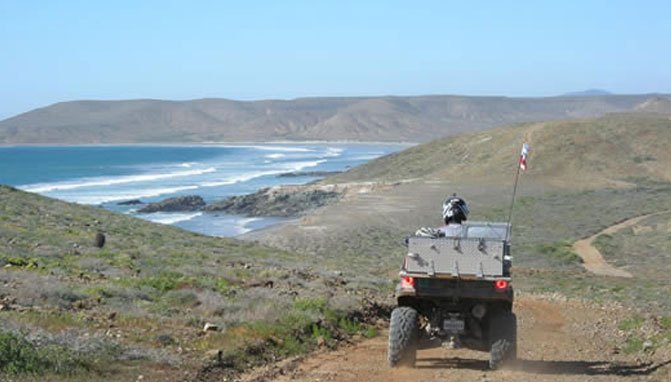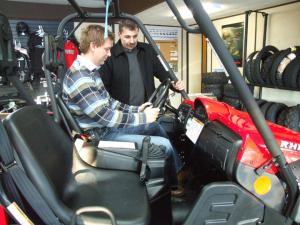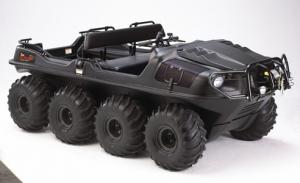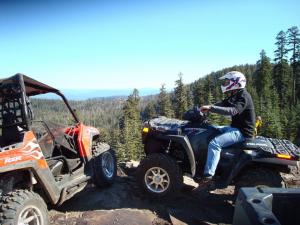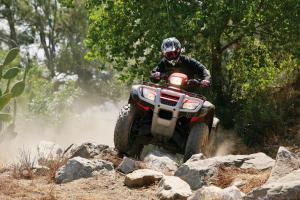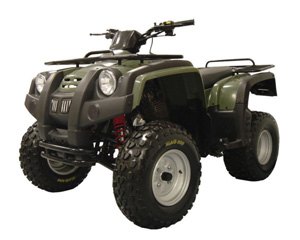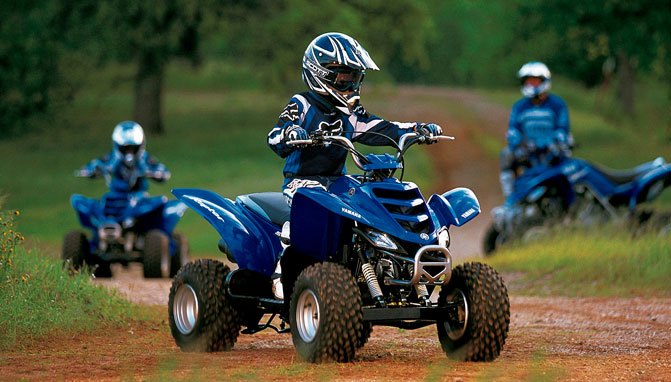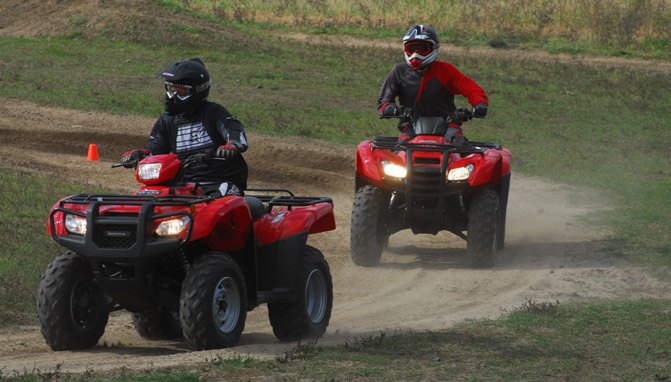Reasons to Ride Your Utility
There are a lot of reasons to build, design and maintain your own private motocross practice track. First and foremost, it gives you, your young racers and your friends an opportunity to practice close to home without paying $20 or more per person – plus gas in your truck – for a day of riding. And it gives you the perfect excuse to buy some accessories for your utility quad and spend some time behind the bars of your workhorse.
But before you push that starter button there are two primary factors to consider: Have you got the land? Do you have access to heavy machinery? If you’re starting from scratch you’re going to need, at minimum, a small bobcat, skid steer or dozer.
Dirt is less of a concern because depending upon the size of your property you can dig a small pond or scrape the lot to compile enough dirt for jump faces, landings, berms and other obstacles.
Keeping Kids Safe on ATVs
As the father of two boys who were born with wheels where their toes should be, I clearly understand the importance of diligent, responsible parenting.
With one son riding his bicycle without training wheels at the ripe old age of three and the other riding a toy electric quad around the backyard track by himself before he could even walk; I know the safety of my children is up to me. What I teach them now will be with them for the rest of their lives. It’s not like a video game where you can simply hit reset when you crash.
Every year off-road recreation becomes more popular as I see more families choosing to spend time in the dunes, desert and trails with their kids riding ATVs, dirt bikes and other off-road vehicles. The use of ATVs in the United States has been steadily increasing over the last decade according to the Consumer Product Safety Commission’s (CPSC) annual report. As these numbers increase it becomes more important to keep our kids safe while riding ATVs, and to educate them about environmental impact and responsibility.
Future Choices for Powersports Drive Systems
At a recent powersports product launch, we sat down to dinner with some engineering and marketing types who gave some interesting perspective on future powersport drivetrains.
Our conversation started out by us asking about the possibility of electric or hybrid drivetrains and was that realistic for powersport vehicles like ATVs. We fully expected the question to get blown off. To our surprise, not only was our question taken — and answered — seriously, but the engineers and marketing/sales types at the dinner table seemed much more than casually informed on the subject.
Our engineer dinner companion seemed versed as to the efficiencies of a hybrid (gas motor combined with electric motor) versus direct electric motor drive system. It was his contention that a hybrid system seemed most likely. He also discussed the use of internal combustion engines that might use fuels other than gasoline.
JP-8 Fuels
US military specifications require vehicles such as Polaris’ Ranger MVRS800 to run on JP-8 military fuel (JP for “jet propellant”), which is a kerosene-based fuel specified by the US military in 1990 and also used by NATO allies. A similar fuel is used in commercial aviation under the name Jet-A. Because the fuel doesn’t gel at low temperatures, JP-8 fuel can be used at science stations at the South Pole.
ATV Trip of a Lifetime
How to Buy a UTV
“Honey, you know how the trail to our camp is really muddy and rough, hey?”
I always add the “hey” when I’m about to ask something to which I know the answer will more than likely be negative.
“Well, I was thinking that if we had one of those side-by-side ATVs, we could go into the camp together and getting in over the trail wouldn’t be a problem.”
A moment of silence, then a reply. “Okay, maybe you should get one then.”
And so began the search for a side-by-side ATV, or UTV, or RUV, or whatever they are called. I anticipated a quick drive around to a few dealerships to size up each of the offerings from the various manufacturers, and expected I’d be in my new side-by-side before the weekend. I mean, how many options could there be in the seemingly young side-by-side market?
Well, too many to mention actually.
2008 UTV Roundup
The UTV category continues to be one of the hottest areas of the ATV business, with technology, innovation and utility driving innovation. Here’s a rundown of what to expect from the major manufacturers for 2008.
Arctic CatArctic Cat’s Prowler UTVs have been turning a lot of heads, and the 2008 models should be the best yet, with the Prowler XTX 700 H1 LE leading the lineup. An Arctic-designed 695cc liquid-cooled single-cylinder 4-stroke powers this Prowler. The company has invested millions of dollars in advanced design and assembly technologies, and this package shows it. The transmission is a rubber-belt high-low-reverse cvt with engine-braking built in. The Prowler is equipped to be a serious terrain conqueror, with push-button four-wheel-drive and a locking front differential.
The 26-inch tires, stunning 12.5-inches of ground clearance and independent double-wishbone suspension at all four-corners (with a swaybar on the back) will inspire confidence for almost any riding conditions. Another feature that the Prowler boasts of is an 8.2-gallon fuel tank. The big Cat has a towing capacity of 1,500 lbs. To top it all off, Arctic has some of the most advanced noise-reduction technology in the industry, and it’s used here to help the Prowler deliver all of this power and performance quietly. Other Prowler models in Arctic Cat’s lineup include the model that started it all—the 650 4×4 Automatic, the 650 XT 4×4 Auto, and the 650 XT 4×4 Auto M4 in wetlands camouflage.
My First Ride
For all intents and purposes, I am an ATV rookie.
Fortunately for me, I was hired because of my journalism background and online production experience. If the powers that be had been looking for an experienced ATV rider, I wouldn’t be writing this article.
However, since I do, in fact, work for ATV.com, I thought it would do me some good to spend some time on the trails.
After getting in touch with Mike Carr, a Polaris district sales manager in northern California, he arranged a day of riding.
I met Carr at his house just outside of Sacramento. We hopped in his truck and headed north upstate about 85 miles and met up with the rest of our party in Chico. After gassing up the vehicles, we drove into the hills about 35 miles northeast of Chico to our starting point in a place called Butte Meadows.
| Things I learned on my first ride | |
| – A broken arm isn’t as big a deal to some people as it is to me.– Washing your road rash with soap and water does not feel good at all. – If you ride behind another ATV, you will eat a lot of dust. – Getting the dust out from between your teeth requires serious flossing. – Trying to hold a pen or operate a keyboard is near impossible a day after gripping a steering wheel or set of handlebars, with all your might, for six hours. – Northern California has some of the best scenery you could ever hope for, as well as some fantastic off-road trails. |
Carr provided a 2008 Polaris Ranger RZR, while Gray Glende, who runs a Polaris dealership in Chico, brought a 2008 Ranger XP and a brand new Sportsman 800 EFI HO. We were also joined by Darren Ritchey, who brought a 2007 Polaris Outlaw and some of Glende’s staff and friends from Chico, who were riding motocross bikes.
On this November morning, there was still a little chill in the mountain air, but the temperature would climb to a comfortable level in short order.
I started the day on the Sportsman 800 and we headed out into the woods on some fire trails. I was a little tentative at first, but I managed to squeeze the throttle enough to reach about 45 miles an hour. This is far below the Sportsman’s capabilities, but I figured I should at least get comfortable before going all out.
About 15 minutes into the ride and before hitting the rough trails, we stopped and did a head count. It seems we were short two riders.
Glende assumed they had taken a wrong turn, but after waiting for a while with no sign of them, Carr headed back in the RZR to see what he could find. He returned a few minutes later, followed by Peter Schmitz on a bike and Ritchey, who seemed to be driving his Outlaw with one hand.
Turns out Ritchey switched off his trusty Outlaw and took a turn on Schmitz’s motocross bike. Apparently it’s difficult to make that particular transition and Ritchey crashed the bike after hitting a rock on the fire trail. His hand now resembled an inflated rubber glove and his arm was broken.
Ritchey was offered a ride back on the Ranger XP, but he said he didn’t want to ruin everybody’s day so he hopped back on the Outlaw with one hand on the throttle and the other in a makeshift sling made out of a fleece jacket and drove back. Schmitz followed on his now damaged bike to help him load up the truck and suddenly our party of eight was now down to six.
Mega-trends in the ATV Industry in 2008
The ATV industry—comprising youth, sport and utility vehicles—has matured into a multi-faceted, highly competitive business. Four-wheelers were once considered a child of the motorcycle industry, but they have now grown to surpass their 2-wheeled siblings in annual sales in North America.
Several key elements are shaping it in 2008:
Trail closures
The ATV industry is under an all-out assault from ‘anti’ groups that want quads and OHVs banned from public land. In a few cases, restrictions are warranted because of abuse and riders disrespecting the property of others. The vast majority of land closures, though, are punitive in nature. ATV Riders seem to be the victim of sheer bigotry. For example, on the Roseau River Wildlife Refuge in northwestern Minnesota, four-wheel-drive trucks continue to be allowed on some roads and trails, but off-highway vehicles have been banned completely from these same trails. No evidence was presented by the DNR that OHVs were causing more damage than trucks; they simply declared OHVs mechana non grata.
Made in China
All terrain vehicles built in China and Taiwan may be in for a rough ride in the US, as the machines have come under criticism that they may be unsafe and are not well made. In addition, some North American and Japanese manufacturers complain these imports don’t have to adhere to the same safety and quality standards as they do.
Established ATV OEMs also claim the foreign machines are being sold at considerably lower prices, and that many of the ATVs—some of which are smaller models meant for children as young as six years old—are being sold on the Internet for less than $500.
Beyond concerns for lost business, larger ATV producers also fear a consumer backlash against the entire industry if these imported vehicles cause any increase in ATV-related injuries.
To fight back, the major North American and Japanese ATV manufacturers have taken the bold move to ask US Congress to approve legislation that would create mandatory safety standards for ATVs.
ATV.com Q & A: Suzuki
ATV.com talked with Rod Lopusnak, ATV operations manager for Suzuki, about his company’s new focus on the ATV market and where he sees the industry going in the future.
ATV.com: Suzuki introduced the industry’s first four-wheeled ATV 25 years ago. What was Suzuki’s biggest innovation to mark the anniversary in 2008?
Lopusnak: I wouldn’t say there has been one innovation, I think what Suzuki has been trying to do in the last few years is give Suzuki dealers an ATV for every one of their customers. I think that finally, coming into 2008, we’ve been able to do that. Before, certain customers might drive past a Suzuki dealer and go to some of our competitors. You’re not seeing that anymore.
ATV.com: Why did Suzuki drop the Eiger line in favor of the KingQuad 400 series for 2008?
Lopusnak: We did that previously with our Boulevard motorcycle line. We did it to further expand our marketing and advertising abilities. KingQuad has got a great name, a huge amount of recognition and a strong brand image so we wanted to continue that. Previously there was only one KingQuad so we expanded that so now we actually have three different KingQuad models, four if you include the automatic and manual version of the 400. We took all the great things about the Eiger in that class and we updated all the things we felt it needed to be a KingQuad, along with the styling and similar features.
ATV.com: Where do you see Suzuki’s ATV business heading in the future?
Lopusnak: The key for us is we want to continue to build on that same plan to keep finding those niches where maybe we’re missing some sales for our dealers and continue to build on that. Continue to build top of the line, award-winning ATVs and give the dealers additional profit centers.
ATV.com: What is the next logical step in ATV production/technology for the industry?
Lopusnak: Safety is always a huge issue and anything we can do to make ATVs safer is going to be there. That’s the unique and great thing that really propelled the growth of ATVs over the last 10 years, because the specialization has been so key. About 10 to 15 years ago there was one ATV and I think the customer specialized it. Now you’re seeing the manufacturer really specialize them, right down to the color.
ATV.com: With fuel consumption an ever-growing concern, how does Suzuki plan to improve the fuel economy of its ATVs?
Lopusnak: We will continue to introduce Suzuki fuel injection. At some point it will be on all our models.
ATV.com: With land use for recreational ATVs becoming a bigger concern, how do you think ATV sales will be affected?
Lopusnak: You will see more and more the manufacturers fight to try and promote the areas that are open and help groom them to be better. We will work with the government and continue on education so we have the ability to get out there and ride.
Page 2
ATV.com: How does Suzuki plan to increase its ATV market share to catch up with Honda, Yamaha and Polaris in the United States?
Lopusnak: We’re going to continue with the marketing plan that we have set. We’re doing a good job. Over the last seven years we’ve basically tripled our market share. Our big losses are in areas that we don’t compete in right now. Every year we’ve kind of added a model or maybe some specialization of certain models to go after a specific segment. It’s really worked well for us. For example, last year out of all the major manufacturers we’re the only one that grew—everybody else went backwards. I think that says a lot for our plan.
ATV.com: What are the key points of differentiation in Suzuki’s ATV product or branding strategy, compared to some of the other OEMs?
Lopusnak: Everybody has their own brand image that they try to go after. That’s one of the things that we talked about earlier with the KingQuads. We’re not going to have five or six different utility models. We’ve been building over the last few years that everything utility is going to be based on a KingQuad, but there will be different levels of a KingQuad. The same thing goes for the recreational rider—it’s going to be QuadSports. When you get to the more performance-minded guy it’s going to be QuadRacers.
ATV.com: Where do you see opportunity for growth for the ATV market? Utility, Sport, or something different entirely?
Lopusnak: Utility is generally very consistent. You might not have that rapid growth in any one area unless you introduce some specific new technology or feature. Otherwise, utility is very consistent. People are finding different ways everyday to use these things, whether it’s golf courses, construction sites, just for recreation and touring, there are just so many different uses.
ATV.com: Geographically, is there a new market out there where an ATV boom is possible?
Lopusnak: There are areas in Europe that are definitely becoming more familiar with ATVs and they are using them. We’re seeing turn signals being put on them and they are actually being driven on the road in the Caribbean and some of the European countries now.
ATV.com: As UTVs/side-by-side vehicles increase in popularity, how much does this market interest Suzuki?
Lopusnak: Our heritage is definitely on the sports side and we’re looking really closely at it and we have built some prototypes. We’re just not sure if and when we’re going to jump in. We’re going to continue to research that and we’ll make a decision probably in the next year.
ATV.com: Do you think the introduction of sportier UTVs will infringe on ATV sales?
Lopusnak: I definitely do, but I don’t think it’s any different than if you introduced another unique ATV with some more specialization. Yes, I think there is going to be some crossover because you are giving people more choices, but it’s no different than if there was a different ATV out there. I really think it’s going to come down to whichever manufacturer specializes the best in the future is going to have the best reward, whether it’s an ATV or a UTV.
ATV.com: What developments and technologies have your competitors introduced to the market that you admire?
Lopusnak: There’s not one that I admire specifically, but the great thing is how good all the products have gotten in the last 10 years. That is just a huge benefit to the customer, because they are getting the opportunity to ride the best product that’s ever been made. You’ve got the best dealers now and it’s easy to get financing. The whole aftermarket world right now is as good as it can be for the customer.
And on a Personal Note:
What is your favorite ATV of all time?
Definitely the LT125, because it changed everything.
Where is your favorite place to ride?
Sport-wise, Pismo Beach or Glamis. For utility, Brimstone in Tennessee.
Your ideal riding partner is?
Somebody a little sportier and aggressive.
Related reading:
2008 Suzuki KingQuad 450
Riding with the King
2007 Suzuki Quadracer R450
The King returns for 2007






